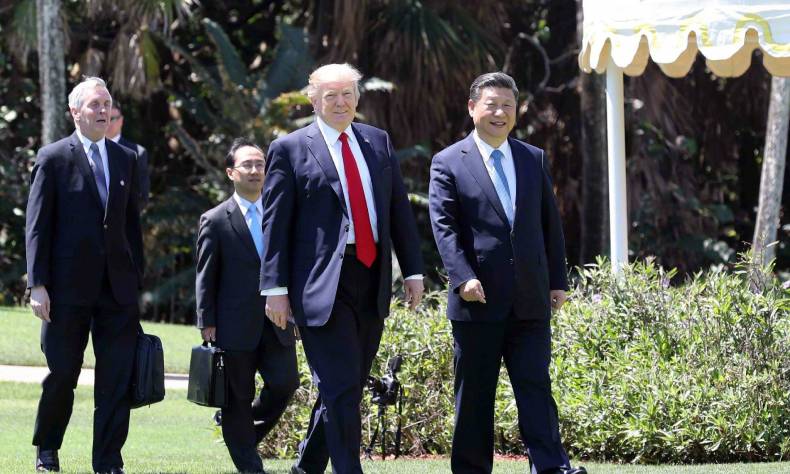
Trump’s Constructive China Policy Anticipated
Is the rise of China a “threat” or an “opportunity”? Is China a “partner” or a “rival”? In the coming few days, the visit of the U.S. President Donald Trump will further confirm the U.S. outlook on China, and White House policies on the relationship.
By Zhang Guoqing
Is the rise of China a “threat” or an “opportunity”? Is China a “partner” or a “rival”? Over the past two decades, these mentalities have entangled the US policy makers in their China strategy, and affected the attitude of US presidents towards China. In the coming few days, the visit of the current president Donald Trump will further confirm the US outlook on China, and White House policies on the relationship.
An active attitude to China’s rise is arguably a positive starting point for Trump’s trip to China, and much can be expected from the visit. It is no easy task for US economists to evaluate the peaceful development of China from a historical perspective, but this visit also provides a chance for them to revise their views.
For some U.S. academics, China’s current development is closer to that of the US in 19th century, rather than eastern Asian countries like Japan or South Korea which emerged in more recent decades. Both China and the US boast vast territory, massive manufacturing capacity, and enormous labor resources. The US was the world’s biggest recipient of capital a century ago, and faced criticism from the outside world that its cheap posed a threat to European industry. Now China faces similar criticism. Obviously, for those who take a rational view of change, China’s peaceful development is nothing to be surprised at, nor need it be a threat or a challenge to other countries.
Regarding this issue, James Sasser, the former U.S. ambassador to China, has a clear understanding. He once commented that the US can treat China’s rise as an opportunity if it so desires, but if it treats China as an enemy, then this will become a self-fulfilling prophecy. Bill Clinton, the former president of the US, made an even shrewder comment – that the US has a lot more to fear from a poor and weak China than from a prosperous and democratic China. In other words, the peaceful development of China is not a threat – rather, it is an opportunity; it is not a problem (either to the region or to the world) – rather, it is the driving force for regional and international economic development.
Having taken too many wrong turns in the past, the US has gradually come to realize that as the two most influential international powers, sustaining and developing a friendly cooperative relationship between China and the US is vital to the Asia and the world. Any responsible U.S. statesman and strategist will clearly recognize the fact that the growing links between the two countries make it harder for the US to harm China without damaging itself, hence to protect its own actual interests, the US must value and strengthen communication and cooperation with China. On this issue President Trump, will surely have a clear understanding, and this can duly be seen from his placatory policies towards China since he took office.
As the two leading powers, China and the US will become increasingly connected not only through their economies, but also by international affairs that concern the interests of both countries. In September 2015, Robert Zoellick, the former president of the World Bank, proposed the idea of “stakeholder” for the first time in a speech in New York. The idea took root in the Washington mindset for a period of time, which led to a harmonious relationship between China and the US after George (W) Bush came to power. Even though president Obama did not mention this idea during his administration, the successes and setbacks of the China-US relationship over the past eight years prove that the two counties are stakeholders with strong and tight connections, and only cooperation can benefit both.
Henry Kissinger said that every government has its own ideas about what are the most important things for the country. For Trump’s government, several key matters can only be properly handled by proactive communication and cooperation with China. This is also the reason why Trump prefers a placatory approach towards China in contrast to the hawks in his government.
However, this does not guarantee a long-term amicable relationship between the two countries. In the eyes of many people, and through the pens of some U.S. media, China is considered to be a rival who could damage the interests of the US. But people of insight can see that there is nothing to be gained by capsizing the vessel that we could call “21st century opportunity” – that will only result in tipping both parties into the water. The appropriate adjustments to the bipartisan relationship will meet the interests of the two countries.
During Trump’s visit, both parties will certainly exchange views on issues that concern both, such as the economy, trade, nuclear proliferation and regional security. Some level of consensus and understanding might be reached. The US will still press hard for some concessions from China. However, the sound communication and exchange can be maintained between the two governments at the top leveld will likely lead to more win-win soutions. This will be a blessing not only to the Asia-Pacific, but also to the world at large, especially in times of turbulence.
Zhang Guoqing, researcher of Institution of American Studies, Chinese Academy of Social Sciences
 Facebook
Facebook
 Twitter
Twitter
 Linkedin
Linkedin
 Google +
Google +










